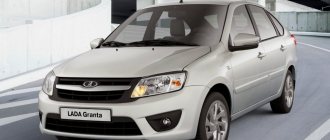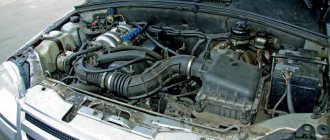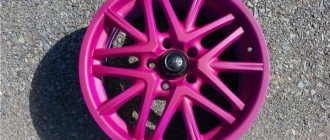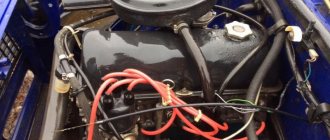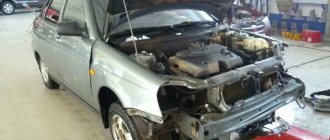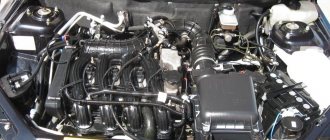The development of this car began back in 1993, and the first copies were shipped to customers only in 2004. In comparison with its predecessors, Kalina is already a modern car that had a fundamentally new design. The car received a new, improved 1.6-liter sixteen-valve engine, and buyers were offered several body styles, including a sedan, hatchback and station wagon. Subsequently, it was decided to abandon the Lada Kalina sedan, offering only station wagons and hatchbacks. The car was in good demand among buyers, lasting on the assembly line for 9 years, after which the second generation of Lada Kalina appeared.
Exterior
During almost 10 years of preparation for production, the design of the Lada Kalina was changed several times. Many car owners and experts note that in appearance the front part of the Kalina is vaguely reminiscent of the Volkswagen Golf, produced in the early 2000s. You shouldn’t expect any special refinements in Kalina’s appearance, but, in comparison with the previously produced VAZ classics, the new car has a truly modern design.
Maintenance
The gas distribution mechanism is driven by a belt, which requires replacement every 45 thousand km. mileage In addition, valve clearances also require periodic adjustment.
A significant advantage of the VAZ 11183 engine is that if the drive belt breaks, hard contact of the valve with the piston surface is eliminated (the valves do not bend).
Maintenance that ensures long-term operation of the power unit comes down to:
- regularly inspect the engine to detect oil and coolant leaks. If any defects are identified, they must be eliminated;
- timely replacement of engine oil - every 15,000 km.
Interior
The interior of the first generation Lada Kalina, although somewhat improved compared to its predecessors, is still frankly outdated, losing to its main competitors, including budget Europeans and Koreans. The quality of the plastic used in the finishing does not stand up to criticism; soon after the start of use, the interior panels creaked mercilessly, and it was almost impossible to get rid of such crickets. Buyers were offered several color options for velor trim, and in top versions it was possible to get cars with headrests in the rear row of seats.
Malfunctions
Motor 11183 is characterized by malfunctions that are typical for all power units produced by AvtoVAZ OJSC.
| FAULTS | CAUSES | REMEDY METHODS |
| The engine does not warm up to the required temperature. | Thermostat is faulty. | Replace thermostat. |
| Knocking and noise in the engine. | 1. Valve clearances are not adjusted. 2. Wear of the crankshaft main bearings. 3. Wear of connecting rod bearings. 4. Pistons knock | Adjust valve clearances. Malfunctions associated with wear of bearings and the need to replace pistons are recommended to be repaired in a specialized car service center. |
| The engine operates unstably (“speeds float”, “troits”, etc.) | 1. The throttle position sensor is faulty. 2. The valve has burned out. 3. The gasket is broken. 4. The ignition module is faulty. | ŸReplace the faulty sensor. Measure compression in cylinders. If it is below normal, then the malfunction is hidden in the gas distribution mechanism. If compression is normal, the fault must be looked for in the ignition module. |
Installed motors
Initially, the Lada Kalina was equipped with a 1.6 liter eight-valve engine developing 81 horsepower. In fact, it was a bored out 1.5 liter engine from a Lada Priora. The engine was quite economical and unpretentious, but one could not expect good dynamics from such a car. Soon, buyers were offered a more modern sixteen-valve 1.4-liter engine, developing a power of 89 horsepower. It was a fairly economical power unit, which consumed 7 liters in the combined cycle, and at cruising speed outside the city about 5 liters per 100 kilometers. The top modifications also offered a 98-horsepower sixteen-valve engine, which was not very popular among car owners because the timing belt on it often broke.
Maintenance
According to AvtoVAZ recommendations, the 11183 engine must be serviced according to the regulations:
| Oil consumption | 0.5 l/1000 km |
| Engine oil for 11183 | 5W-30 and 10W-40 |
| Engine oil volume | 3.5 l |
| Operating temperature | 95° |
| Motor life | declared 150,000 km, |
| Adjustment of valves | washers between camshaft cams and tappets |
| Cooling system | forced, antifreeze/antifreeze |
| water pump | plastic impeller |
| Candles for 11183 | BPR6ES, A17DVRM |
| Gap between spark plug electrodes | 1.1 mm |
| Timing belt | Gates |
| Cylinder operating order | 1-3-4-2 |
| Air filter | Nitto, Knecht, Fram, WIX, Hengst |
| Oil filter | catalog number 90915-10001 |
| Flywheel | from 2110 |
| Valve stem seals | code 90913-02090 light inlet |
| Compression | cylinder pressure from 13 bar nominal |
| XX speed | 800 – 850 min -1 |
| Tightening force of threaded connections | spark plug – 18 Nm |
| Maintenance object | Time (month) or mileage (10,000 km) |
which comes first
Prices and options
Lada Kalina was offered to customers in Standard, Norma, and Lux trim levels. As it was on the assembly line, the list of basic and optional equipment on this car was constantly expanding. If initially air conditioning and parking sensors were available only in the luxury configuration, then later they were offered to be installed on the Norma configuration for an additional fee. Some versions of Kalina received a standard audio system and other options that provide driving comfort and improve the safety of the driver and passengers. For the first time on VAZ cars, power steering was already used as standard on Kalina, which made it much easier to control the car at low speeds.
The first generation Lada Kalina station wagon, which appeared in 2009, was very popular among buyers. This car, despite its small dimensions, had a spacious trunk, and the rear seats could be folded down, easily transporting large items in the cargo compartment. The Luxury trim received not only air conditioning and parking sensors, but also an airbag for the driver, as well as an anti-lock braking system. This modification was equipped with a powerful 1.6-liter engine, but only a manual transmission was available.
The cost of the first Lada Kalina was about 200 thousand rubles, and for top modifications they asked for 220-250 thousand rubles. Subsequently, the list of standard equipment only expanded, the price invariably increased, which rose to 300 thousand rubles. With such an initially low cost, the car was in good demand on the market, especially since its maintenance was not difficult, and most of the service work and repairs were carried out by car owners themselves.
Specifications
| 1) module replacement | ||
| Extraneous noise | 1) misadjustment of valve clearances | |
| 1)adjustment with valve gaskets | ||
| Alternator belt break | excessive tension, manufacturing defect | Regular check, replacement as necessary |
| PARAMETER | MEANING |
| Cylinder displacement, cubic meters cm | 1.596 |
| Rated power, l. With. (at 5200 rpm) | 82 |
| Maximum torque, Nm (at 2700 rpm) | 120 |
| Number of cylinders | 4 |
| Number of valves per cylinder, pcs. | 2 |
| Total number of valves, pcs. | 8 |
| Cylinder diameter, mm | 82 |
| Piston stroke, mm | 75.6 |
| Spark plug | A17 DVRM, BPR6ES (NGK), etc. |
| Cylinder operation diagram | 1 – 3- 4- 2 |
| Supply system | Injector (electronically controlled distributed injection) |
| Fuel | Unleaded gasoline AI-92 |
| Fuel consumption, l./100 km. (city/highway) | 8,8/5,7 |
| Lubrication system | Combined (spraying + under pressure) |
| Engine oil type | 5W-30, 5W-40, 10w-30 and 10W-40 |
| Engine oil quantity, l | 3.5 |
| Cooling system | Liquid, closed type |
| Coolant | Based on ethylene glycol |
| Motor resource, thousand hours. (theory/practice) | 150/300 |
| Weight, kg | 127 |
Advantages of Lada Kalina
Car owners generally spoke positively about the first generation Lada Kalina, noting its efficiency and good reliability. The car was offered at an affordable price, which was significantly lower than that of inexpensive European and Korean cars of similar class. The advantages also include low operating costs; spare parts for the Lada Kalina cost pennies, and many of the jobs could be done yourself without contacting a service center.
At the beginning of the 2000s, Lada Kalina was a significant step forward in terms of cabin soundproofing. Compared to its predecessors, the new car was significantly quieter, including at high speed. The new car had a roomy interior, especially for the hatchback and station wagon versions.
The 1.6-liter carburetor engine, simple in design, did not cause much trouble for car owners; it could be overhauled independently, critical breakdowns were extremely rare, and the service life was about 200 thousand. The same applies to the chassis, which, although it was quite rigid, was durable and trouble-free to maintain.
Description
Like all previous models, the VAZ 11183 engine is a classic four-stroke, in-line, 4-cylinder power unit with an overhead camshaft.
The increase in cylinder volume was achieved through the use of a higher cylinder block than that of the prototype. Its height is 2.3 mm higher than the height of the 2111 engine block and is 197.1 mm (from the crankshaft axis to the top surface). The diameter of the cylinders did not change, but the dimensions and shape of the combustion chamber had to be changed.
The cylinder head is made of aluminum alloy. A camshaft is installed in its upper part, and special ducts are cast in the lower part, designed to supply coolant to the combustion chambers. The same channels are also available in the cylinder block housing.
The crankshaft and camshaft of the engine are cast from cast iron, the pistons are made from aluminum alloy. Forged connecting rods (steel).
Disadvantages of the first generation Lada Kalina
Many car owners spoke negatively about the quality of the body metal, which began to rust even in the absence of visible damage, scratches or chips. There were numerous problems with the electrical system, which was not very reliable, and numerous electronic sensors often malfunctioned and required replacement.
Another weak point of this car is the injection engine, which often failed, after which it was necessary to diagnose the injection and repair the fuel system. The weak stove deserves special criticism, as it could not heat the car interior in winter even after 15-20 minutes of driving.
One could not expect good dynamics from a car with an engine power of 80-90 horsepower. The car clearly lacked power both on the highway and when accelerating in the city from traffic lights. Cars with high mileage could also experience problems with the cooling system, which led to frequent engine overheating in hot weather.
10.03.2021
Malfunctions: causes, elimination
If the timing belt of the drive breaks, the 11183 motor does not bend the valve, but it has the following typical breakdowns:
| Timing drive | 36/ 1 |
| Battery | 12/2 |
| Valve clearance | 24/2 |
| Crankcase ventilation | 24/2 |
| Belts that drive attachments | 24/2 |
| Fuel line and tank cap | 24/2 |
| Engine oil | 12/1 |
| Oil filter | 12/1 |
| Air filter | 12 – 24/4 |
| Fuel filter | 48/4 |
| Heating/cooling circuits | 24/4 |
| coolant | 24/4 |
| Oxygen sensor | 10 |
| Spark plug | 12 – 24/2 |
| Exhaust manifold | 12/1 |
| Floating speed | 1) malfunction of the ignition module |
4) failure of the TPS sensor
2) installing a new gasket
4) repair or replacement of the throttle position sensor
4) production of liners
2) replacement of pistons, rings
4) use of new liners
Since a feature of the ICE 11183 is a well-thought-out design of valves and pistons, overhauls in most cases are carried out on time without additional user investment.
